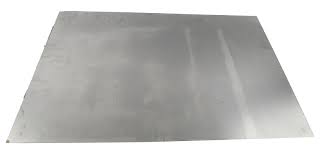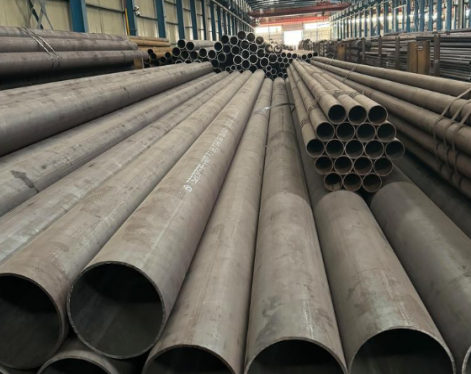Steel plate is one of the most widely used steel materials in various fields of industry and civil use. It is used to manufacture various boxes or shells, containers, covers, pipes, mechanical parts, etc. with cutting, stamping, welding, machining and other processing technologies.
Steel plate is also one of the most widely used and largest metal materials in automotive products. It is mainly used in parts and assemblies such as car bodies, carriages (boxes), chassis and wheels. According to rough statistics, depending on the car model, the amount of steel plate used accounts for about 55-80% of the amount of steel used in automobiles.
Steel plate (steel strip) production process
Mining → Ore dressing → Sintering/pelletizing → Blast furnace ironmaking → Electric/converter steelmaking → Refining outside the furnace → Continuous casting/die casting → Rough rolling → Finishing rolling → Heat treatment → Hot rolled steel plate (coil) → Pickling → Hot rolled pickled steel plate (coil) → Cold rolling → Annealing → Cold rolled steel plate (coil) → Coating treatment → Coated steel plate (coil) → Other treatments → Composite steel plate, etc.
(1) Most of them adopt cold stamping: body cover parts , various structural parts, etc.
(2) Some parts are rolled: longitudinal beams, slides, guide rails, etc.
(3) A few parts are spun: rims, pulleys, shells, etc.
Hot stamping: bridge shells
Internal high pressure forming: suspension/exhaust/steering system parts, etc.
Front/rear subframe (Bentium)
Hot forming: B-pillars, center channels, front fenders,crossbeams, front fender lower plates, etc.
The classification of automotive steel plates is only a general distinction and definition, aimed at facilitating technical exchanges and selection of steel plates. Generally, there are The following categories:
(1) According to the rolling process, it is divided into: hot-rolled steel plate, hot-rolled pickled steel plate, cold-rolled steel plate;
(2) According to the surface treatment, it is divided into: ordinary steel plate, coated steel plate, galvanized steel plate;
(3) According to the strength level, it is divided into: ordinary strength steel plate, high strength steel plate, ultra-high strength steel plate, ultra-high strength steel plate;
(4) According to the chemical composition, it is divided into: high carbon, ordinary carbon, low alloy, micro alloy and alloy steel plate (including stainless steel plate);
(5) According to the metallographic structure, it is divided into: ferrite steel plate, bainite steel plate, martensite steel plate =Martensitic steel plates, etc.
(6) According to the stamping level, they are divided into: general, stamping, deep drawing, and ultra-deep drawing;
(7) According to the use of parts, they are divided into: beam steel plates, wheel steel plates, bridge housing steel plates, transmission shaft tube steel plates, spring steel plates, etc.
(1) China
China tends to divide automotive high-strength steel plates into two categories:
① Ordinary high-strength steel plates
High-strength steel plates with relatively low tensile strength or yield strength, or can be produced by traditional processes or with a little improvement of traditional processes. Such as bake-hardened steel plates, phosphorus-containing steel plates, high-strength IF steel plates, and HSLA steel plates.
② Advanced high-strength steel plates
Steel plates that require advanced equipment and process methods to produce, such as dual-phase steel plates (DP steel plates), complex phase steel plates (CP steel plates), phase transformation induced plasticity steel plates (TRIP steel plates), martensitic steel plates (M steel plates or Mart steel plates), and twinning induced plasticity steel plates (TWIP steel plates).
(2) Japan
① Ordinary strength steel plate
Hot-rolled steel plate with tensile strength <490MPa and cold-rolled steel plate with tensile strength <340MPa.
② High-strength steel plate
Hot-rolled steel plate with tensile strength ≥490MPa and cold-rolled steel plate with tensile strength ≥340MPa.
(3) Germany
① High-strength steel plate (HSS): steel plate with yield strength of 180MPa≤<300MPa;
② Advanced high-strength steel plate (AHSS): steel plate with yield strength of 300MPa≤<600MPa;
③ Ultra-high strength steel plate (UHSS): steel plate with yield strength ≥600MPa.
(4) ULSAB organization
① Ordinary strength steel plate: hot-rolled steel plate with yield strength <210MPa;
② High-strength steel plate (HSS): hot-rolled steel plate with yield strength of 210MPa≤≤550MPa;
③ Ultra-high strength steel plate (UHSS): hot-rolled steel plate with yield strength >550MPa.
Steel plate is also one of the most widely used and largest metal materials in automotive products. It is mainly used in parts and assemblies such as car bodies, carriages (boxes), chassis and wheels. According to rough statistics, depending on the car model, the amount of steel plate used accounts for about 55-80% of the amount of steel used in automobiles.
1.Manufacturing process of auto sheet metal
Steel plate (steel strip) production processMining → Ore dressing → Sintering/pelletizing → Blast furnace ironmaking → Electric/converter steelmaking → Refining outside the furnace → Continuous casting/die casting → Rough rolling → Finishing rolling → Heat treatment → Hot rolled steel plate (coil) → Pickling → Hot rolled pickled steel plate (coil) → Cold rolling → Annealing → Cold rolled steel plate (coil) → Coating treatment → Coated steel plate (coil) → Other treatments → Composite steel plate, etc.
2. Automotive sheet metal forming process:
(1) Most of them adopt cold stamping: body cover parts , various structural parts, etc.(2) Some parts are rolled: longitudinal beams, slides, guide rails, etc.
(3) A few parts are spun: rims, pulleys, shells, etc.
Hot stamping: bridge shells
Internal high pressure forming: suspension/exhaust/steering system parts, etc.
Front/rear subframe (Bentium)
Hot forming: B-pillars, center channels, front fenders,crossbeams, front fender lower plates, etc.

3. Classification of automotive steel plates
The classification of automotive steel plates is only a general distinction and definition, aimed at facilitating technical exchanges and selection of steel plates. Generally, there are The following categories:(1) According to the rolling process, it is divided into: hot-rolled steel plate, hot-rolled pickled steel plate, cold-rolled steel plate;
(2) According to the surface treatment, it is divided into: ordinary steel plate, coated steel plate, galvanized steel plate;
(3) According to the strength level, it is divided into: ordinary strength steel plate, high strength steel plate, ultra-high strength steel plate, ultra-high strength steel plate;
(4) According to the chemical composition, it is divided into: high carbon, ordinary carbon, low alloy, micro alloy and alloy steel plate (including stainless steel plate);
(5) According to the metallographic structure, it is divided into: ferrite steel plate, bainite steel plate, martensite steel plate =Martensitic steel plates, etc.
(6) According to the stamping level, they are divided into: general, stamping, deep drawing, and ultra-deep drawing;
(7) According to the use of parts, they are divided into: beam steel plates, wheel steel plates, bridge housing steel plates, transmission shaft tube steel plates, spring steel plates, etc.
4. Classification of steel plates of different strength levels
(1) ChinaChina tends to divide automotive high-strength steel plates into two categories:
① Ordinary high-strength steel plates
High-strength steel plates with relatively low tensile strength or yield strength, or can be produced by traditional processes or with a little improvement of traditional processes. Such as bake-hardened steel plates, phosphorus-containing steel plates, high-strength IF steel plates, and HSLA steel plates.
② Advanced high-strength steel plates
Steel plates that require advanced equipment and process methods to produce, such as dual-phase steel plates (DP steel plates), complex phase steel plates (CP steel plates), phase transformation induced plasticity steel plates (TRIP steel plates), martensitic steel plates (M steel plates or Mart steel plates), and twinning induced plasticity steel plates (TWIP steel plates).
(2) Japan
① Ordinary strength steel plate
Hot-rolled steel plate with tensile strength <490MPa and cold-rolled steel plate with tensile strength <340MPa.
② High-strength steel plate
Hot-rolled steel plate with tensile strength ≥490MPa and cold-rolled steel plate with tensile strength ≥340MPa.
(3) Germany
① High-strength steel plate (HSS): steel plate with yield strength of 180MPa≤<300MPa;
② Advanced high-strength steel plate (AHSS): steel plate with yield strength of 300MPa≤<600MPa;
③ Ultra-high strength steel plate (UHSS): steel plate with yield strength ≥600MPa.
(4) ULSAB organization
① Ordinary strength steel plate: hot-rolled steel plate with yield strength <210MPa;
② High-strength steel plate (HSS): hot-rolled steel plate with yield strength of 210MPa≤≤550MPa;
③ Ultra-high strength steel plate (UHSS): hot-rolled steel plate with yield strength >550MPa.
Previous:Advantages of H-pile









